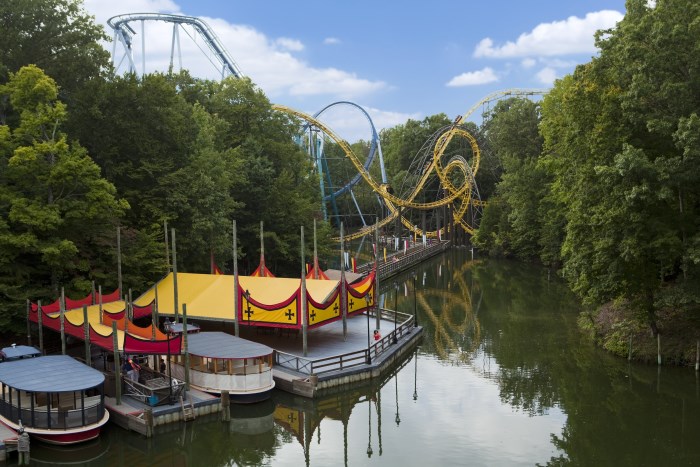Recently, I took my family to Busch Gardens Williamsburg. We had a great time riding rides and seeing performances, but I also wanted to use the trip as a learning opportunity. I want my kids to relate learning to the real world and to associate learning with fun experiences. Here are six fun ways that you can turn your trip into a learning experience about amusement park physics and more:
1. Bring learning into the discussion
Lerner.org provides a great interactive activity around amusement park physics and science, but they also provided a helpful glossary of some common scientific concepts that could be discussed with your kids at the amusement park. Here are a few:
- Acceleration. Objects that are changing their speed or their direction are said to be accelerating. The rate at which the speed or direction changes is referred to as acceleration. Some amusement park rides (such as roller coasters) are characterized by rapid changes in speed and or direction. These rides have large accelerations. Rides such as the carousel result in small accelerations; the speed and direction of the riders change gradually.
- Gravitational force. Any two objects with mass attract each other with a type of force known as a gravitational force. The strength of this force depends upon the mass of the two objects and the distance between them. For objects with masses as large as the earth and the sun, these forces are strong and have tremendous influence upon the subsequent motion. For objects such as two persons sitting in a theater, the force of gravitational attraction is so small that it is insignificant. In order for such persons to increase the force of attraction between them, they must add to their mass (maybe by eating more popcorn). Objects on the earth experience noticeable attractions with the earth due to the earth’s large mass
- Newton’s First Law of Motion. An object at rest or in uniform motion in a straight line will remain at rest or in the same uniform motion unless acted upon by an unbalanced force. This is also known as the law of inertia.
NASA has also produced a great PDF around amusement park physics that has fun activities and lessons about amusement park rides to help teach students physics. I am sure we sounded funny discussing these concepts while walking around the park, but it was amazing to see my kids retain some of these concepts after discussing them in relationship to the rides we rode.
2. Education Days
Many theme parks, including Disney, Cedar Fair, and Busch Gardens offer Education Days or camps that explain the science behind the rides. Here is an example description of a Thrill U Education Day from King’s Island in Ohio:
“Doubling as an outdoor classroom, Kings Island brings learning to life! Students have the opportunity to gain a greater understanding of the basics of science, technology, engineering and mathematics in a fun and interactive setting. Interactive educational stations will be set up throughout the park and operated by COSI (Center of Science and Industry) personnel during each Education Day programming date. They’ll provide hands-on activities to demonstrate the science behind select rides in the park! ”
Make sure to look at the parks’ websites to determine dates and costs. In addition, there are often specific dedicated days and activities for homeschoolers.
3. Behind the Scenes Tours
If an entire day or camp is too much for your kids, many parks also offer “Behind the Scenes” tours that explain the inner workings of the parks on a wide range of subjects, from roller coaster tours to botanical tours. These tours often explain the science and thinking behind how the park operates. For instance, Busch Gardens offers the opportunity for kids 8 and up to learn about roller coasters through their roller coaster tours. The Roller Coaster Insider allows special rides of five of the Busch Gardens coasters and also teaches about the history and mechanics of the roller coasters. Themeparkinsider.com wrote a review of the tour and had this to say, “Any theme park fan interested in a unique look at some of the most exciting steel roller coasters in the country should definitely give Busch Gardens Williamsburg Coaster Insiders Tour a try.”
4. Exhibits and shows
Parks often offer free or relatively inexpensive exhibits and shows for kids to participate in or watch. These activities run the gamut from hunting for dinosaurs to listening to music and get kids directly involved in the experience. In one day at Busch Gardens we were able to learn about eagles, wolves, and Clydesdales and then attend shows featuring Irish dancing and British rock music, all for no additional cost.
5. Use LearningLiftoff.com Learning Activities to teach concepts related to the amusement park
For instance, Busch Gardens Williamsburg has a European theme, which goes along with the following activities for my kids to try:
- Watch and listen to the 7 Continents Song to learn the names of all of the continents.
- Use the Kindergarten History Learning Activity: Map of Europe to teach my kids various countries in Europe.
- For more of a science focus:
- Have them try the Kindergarten Science Learning Game: Push or Pull and then look at the different rides and discuss push or pull motions.
- Go over their senses using our Kindergarten Science Learning Activity: Senses Club and then have them describe what senses they use at the park.
6. Track your walking around the park
Using your smart phone or pedometer to track your steps around the park can be the start of a fun learning activity. You can work with your child to engage in math exercises to determine how far you walked, how many steps equal a mile, convert miles to kilometers, or calculate your miles per hour. Hershey Park has a fun fitness learning guide which has fitness activities that could be adapted to any amusement park.
If you have any thoughts or ideas around turning a trip to the amusement park into a learning experience, please let us know in the comments below.





































